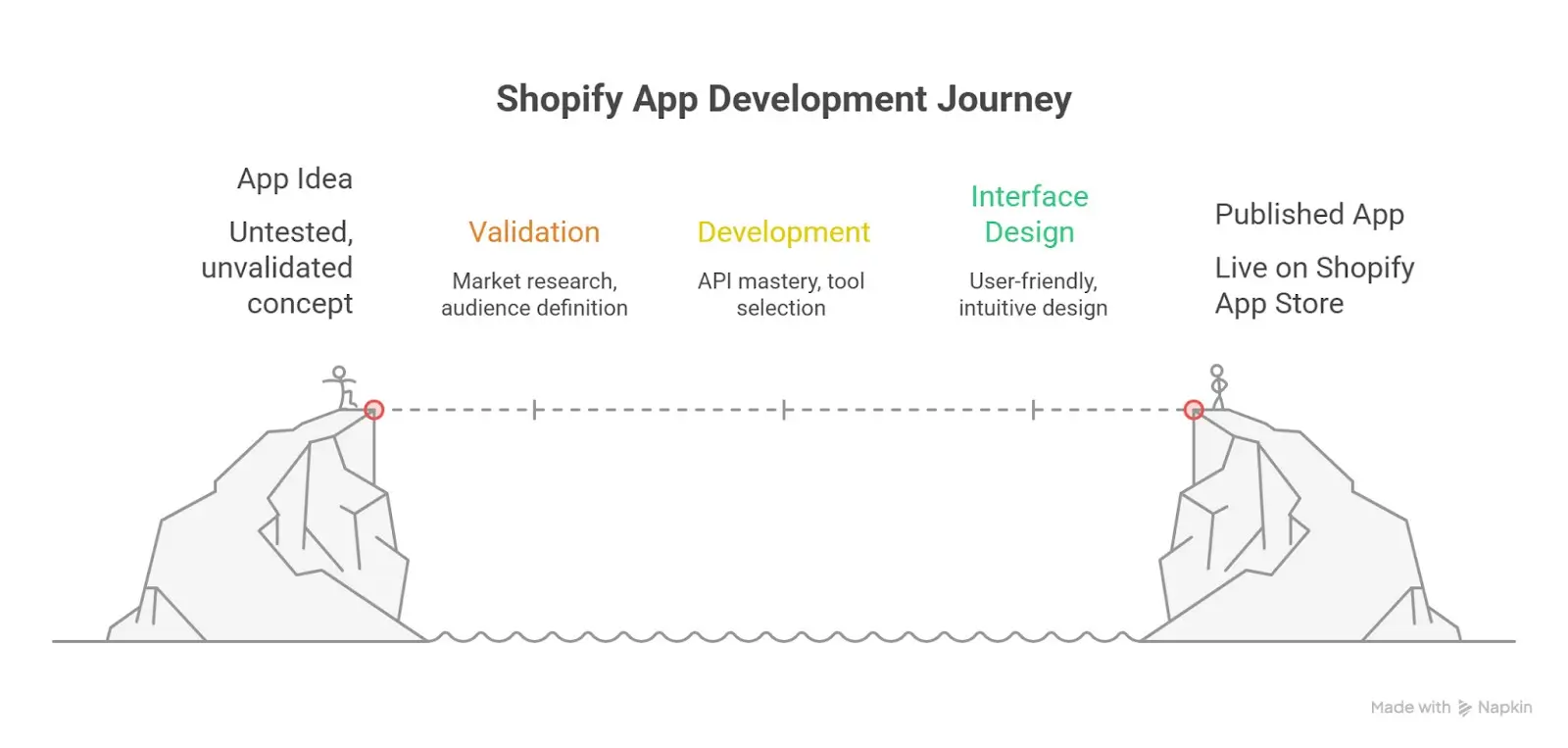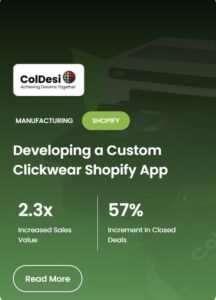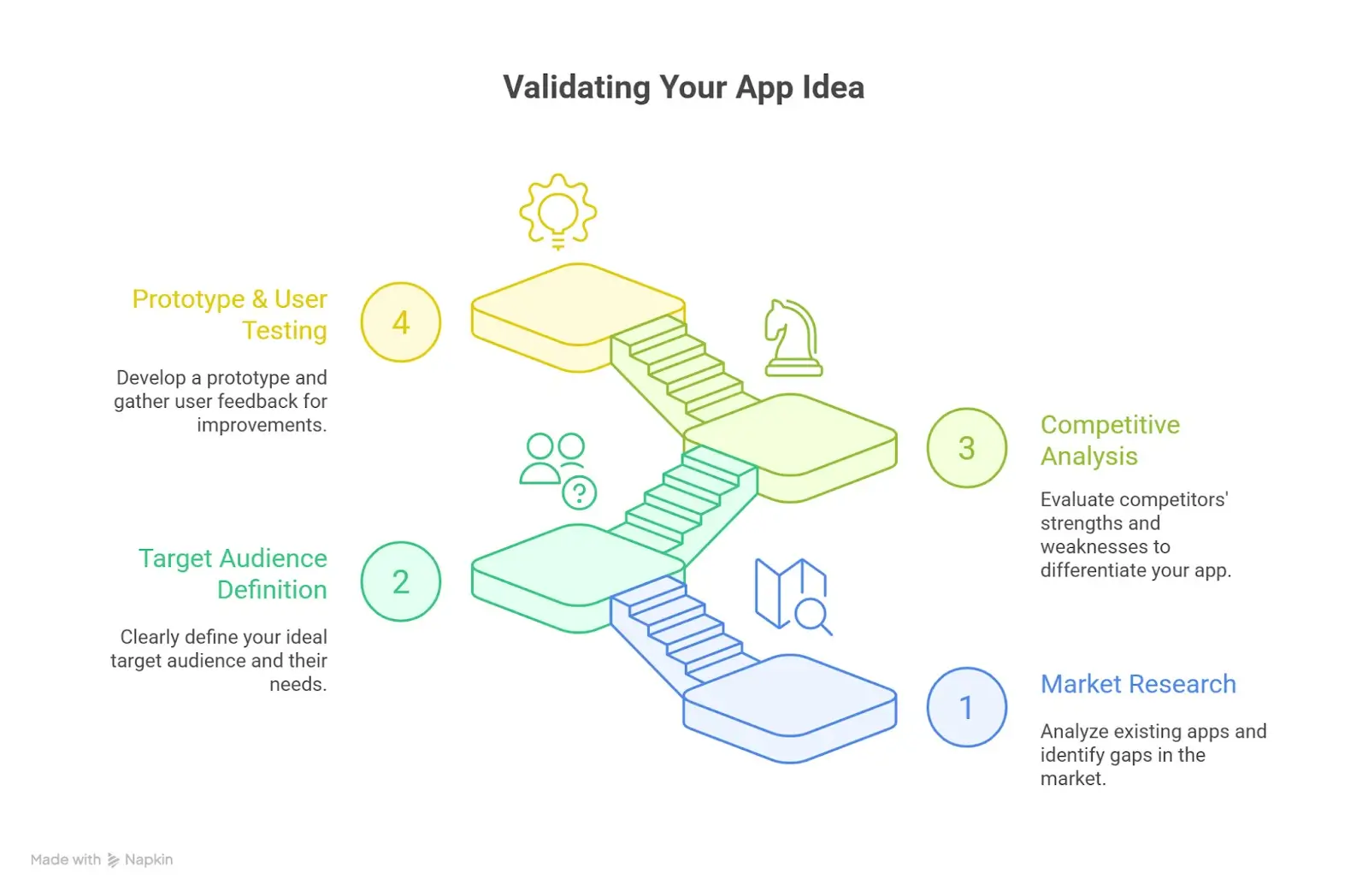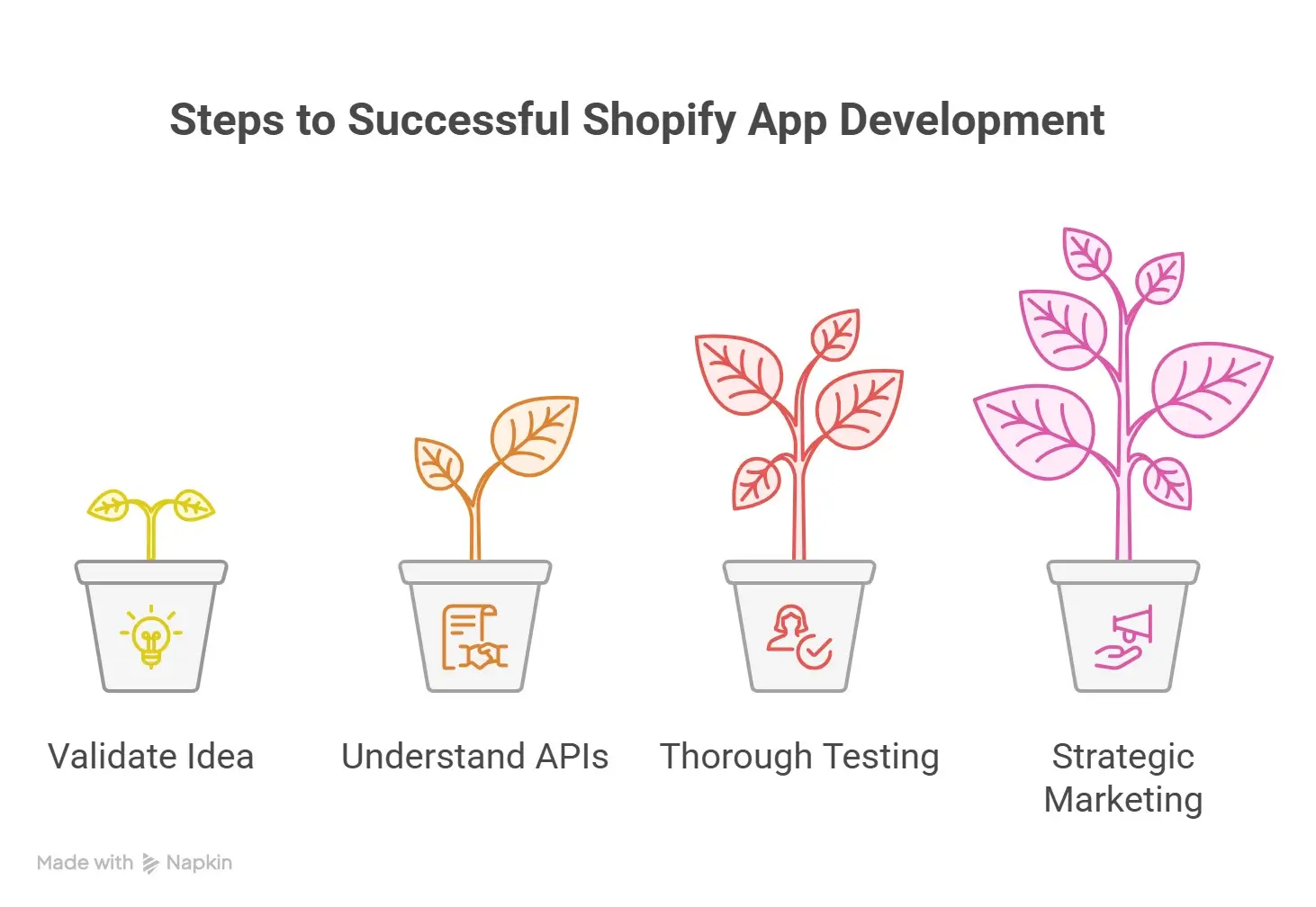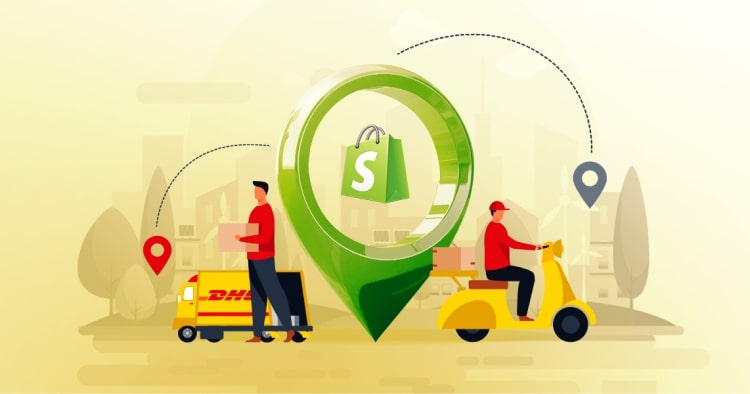Shopify is a platform that does not distinguish between a new seller just starting in eCommerce and a well-established online store. It gives an equal chance to every merchant on its platform, especially when it comes to Shopify custom app development.
As a merchant, you may have discovered that the platform lacks certain capabilities or functionalities. This is where custom apps come into play – they allow you to extend the platform’s capabilities to better suit your business needs.
These custom apps are important for merchants, and most of the merchants use them to improve their stores, but if you haven’t used an app before for your store, it might be difficult to get started right away. If you already have an app idea in mind but do not have the time or in-house expertise to build it, a trusted Shopify custom app development partner can take care of the heavy lifting for you – from validating the idea to launch and ongoing support.
Therefore, we came up with the idea to help you understand how to create your very first Shopify custom apps. Whether you are a fast-growing brand, an agency managing multiple Shopify stores, or a SaaS team that needs a deep Shopify integration, this guide will help you decide when to build in-house and when to bring in a specialist team to build the app for you.
Explore our comprehensive step-by-step resource: How to Create Shopify App for hands-on instructions. We’ve also added some great advice from the best Shopify developers at Folio3, who know this platform like the back of their hand!
Summary
This comprehensive guide covers everything you need to know about Shopify custom app development:
- When to partner with a Shopify custom app development team – How to decide if it makes more sense to outsource strategy, development, and maintenance instead of building and managing everything yourself.
- Understanding Shopify’s App Ecosystem – How apps integrate with Shopify, different app types, and the role of the Shopify App Store in custom development.
- Validating Your App Idea – A four-step validation process including market research, audience definition, competitive analysis, and prototype testing to ensure your app concept is viable.
- Mastering Shopify’s API – Understanding REST API and GraphQL API to enable seamless interaction between your custom app and the Shopify platform.
- Choosing Development Tools – Selecting the right programming language and framework based on team expertise, budget, and app complexity.
- Building User-Friendly Interfaces – Creating intuitive, visually appealing designs through wireframing, UX optimization, and feedback mechanisms.
- Testing and Quality Assurance – Implementing unit testing, integration testing, and user testing strategies to ensure bug-free functionality.
- Publishing and Marketing – Steps to launch your app on the Shopify App Store or keep it private, plus proven marketing strategies.
- Installation Guide for Merchants – A step-by-step walkthrough for store owners to find and install custom Shopify apps.
Getting Started with Shopify Custom Apps Development
Before we get into the technical details of a custom Shopify app development, let’s first understand what Shopify has to offer in terms of apps.
The platform’s dynamic app ecosystem offers a variety of useful tools and extensions, especially for Shopify merchants looking to improve their online storefronts. By easily integrating with your existing infrastructure, the app contributes as digital assistants to unlock new avenues for revenue generation.
This guide is especially useful if you:
-
Feel limited by off‑the‑shelf apps that cannot handle your unique workflows or business rules.
-
Spend too much time on manual tasks that could easily be automated inside Shopify.
-
Need custom integrations between Shopify and ERPs, CRMs, 3PLs, or marketplaces.
-
Want to offer a differentiated shopping experience that standard apps simply cannot provide.
If any of these sound familiar, a tailored custom Shopify app built by experienced developers can remove bottlenecks and unlock new revenue opportunities for your store.
To navigate this vast expanse properly, let’s understand the following key aspects:
1. How Apps Fit Into Shopify
The app is an integral part of this platform, accelerating the functionality and customization options for merchants and buyers. This calls for understanding how applications fit into Shopify for maximum for a trouble-free approach. The smooth fusion of apps extends its capabilities in various ways:
- Streamlines Operations: From inventory management and order fulfillment to shipping and returns, apps automate tasks. All that promises you valuable time and resources.
- Upgrades Customer Experience: Personalize marketing campaigns, implement loyalty programs, and offer omnichannel support to induce brand loyalty.
- Open Up New Doors: Integrate social selling tools, explore subscriptions and recurring payments, or expand your reach through additional sales channels.
Explore our blog on Clover Shopify Integration for practical third-party app connection strategies.
2. App Types
Shopify’s app ecosystem boasts a diverse array of applications. They range from marketing tools and inventory management to payment gateways and customer service enhancements.
Merchants can use these applications to tailor their online stores to suit specific requirements. After all, a personalized shopping experience gives buyers an ultimate edge over competitors.
Whether a business seeks to organize its day-to-day actions, boost marketing efforts, or ease the checkout process, the extensive range of app types allows for precise customization.
3. Merchant and Buyer Data
Calling Shopify’s custom development a way to strike a balance between buyers’ and merchants’ data would not be wrong. Its crucial role in handling merchant and buyer data has immense importance.
From analytics tools to secure payment gateways, these applications prioritize data security and privacy. Merchants leverage this information to refine their strategies. Buyers trust that their data is in safe and responsible hands. Hence, it fosters a sense of trust and reliability in the Shopify ecosystem.
4. The Shopify App Store
The app store is the central hub for accessing and discovering a vast selection of apps. From there, merchants can explore categories, read reviews, and find applications that align with their business goals.
Its collection aims to help users have access to high-quality, reliable apps that have been vetted for performance and security. In short, this store is a one-stop shop for various merchants who are searching for it.
How to Validate Your App Idea
Before you begin your custom app Shopify development, a crucial step awaits. Like scientific inquiry, you need that idea validated to assess its viability and market fit.
4 Steps to Validate Your Shopify Custom Apps Development Idea
To develop the Shopify app, it is also important to learn how to validate the app idea. The steps are:
1. Market Research
When commencing your journey, do not forget to do deep market research. It includes analyzing existing applications within your chosen niche and identifying solutions and potential gaps.
Also, look for specific recurring pain points or areas lacking robust solutions. This research paints a vivid picture of the market landscape and informs your app’s value proposition.
2. Target Audience Definition
Clearly define your ideal target audience. Consider the industry, store size, and specific business challenges.
You should also check out their purchasing habits and technological preferences. That is how you end up understanding your audience intimately for more conversions.
3. Competitive Analysis
You can evaluate their strengths, weaknesses, pricing models, and user reviews by thoroughly analyzing existing but relevant apps.
This competitive analysis identifies opportunities for differentiation. Plus, it assists in creating an app that surpasses existing solutions by offering unique features.
4. Prototype & User Testing
Develop a basic prototype of your app to demonstrate its core functionality. This tangible representation serves as a springboard for gathering valuable user feedback.
To gauge potential users’ reactions, opt for surveys, interviews, and beta testing. Analyze their feedback meticulously, seeking to identify areas for improvement and ensure your app resonates with its intended audience.
5. Real-world custom app example
One growing Shopify brand we worked with was struggling to manage complex wholesale pricing and manual order approvals across multiple regions.
Our team designed and built a custom Shopify app that automated pricing rules, approvals, and notifications directly inside the admin.
As a result, the merchant reduced manual workload for their team, eliminated pricing errors, and unlocked new wholesale revenue without adding headcount.
Related Read: How Much Does It Cost To Build A Shopify App
Featured Success Story: ColDesi Clickwear App
See how a custom Shopify app built for ColDesi’s Clickwear solution increased sales value by 2.3x and boosted closed deals by 57%.
APIs and Frameworks in Shopify Custom Apps Development
Building a custom app for your store begins with mastering API. The API serves as a conduit, enabling your app to interact with the Shopify platform without hassle.
The foundational block of this custom development presents two primary types of APIs: REST API and GraphQL API. The REST API offers a straightforward approach to read and write shop data, making it suitable for shorter applications. On the other hand, the GraphQL API facilitates more complex data manipulation, allowing for efficient data loading. Get platform-specific insights with our guide to the Shopify Dev Platform.
Projects like the ColDesi Clickwear app started with a quick discovery call just like this.
Understanding Shopify’s API
Building a custom app for your store begins with mastering Shopify’s API. The API serves as a conduit, enabling your app to interact with the Shopify platform without hassle.
The foundational block of this custom development presents two primary types of APIs: REST API and GraphQL API.
The REST API offers a straightforward approach to read and write shop data, making it suitable for simpler applications. On the other hand, the GraphQL API facilitates more complex data manipulation, allowing for efficient data loading.
Understanding these API frameworks is essential when you’re learning how to build Shopify app solutions. They provide the backend infrastructure that powers your custom application’s functionality.
With API knowledge under your belt, selecting the appropriate programming language becomes your next strategic decision.
If your team does not have deep API experience, working with certified Shopify app developers ensures your app is architected correctly from day one, with secure, scalable integrations that will not break as your store grows.
Choosing the Right Programming Language
An appropriate programming language is a pivotal part of the Shopify apps development process. This decision hinges on various factors, including your app’s complexity, budget constraints, and the skill set of your development team.
Above all, your team’s proficiency matters the most. So, opt for a language your development team is adaptive to streamline the development process.
Then comes the turn of checking for community support. Languages with robust developer communities can offer invaluable support in the present and future.
Popular programming languages for Shopify app development include:
- Ruby on Rails – Shopify’s native language, ideal for backend development
- JavaScript/Node.js – Great for both frontend and backend applications
- PHP – Widely used with strong community support
- Python – Excellent for data-heavy applications and integrations
- React/Angular – Perfect for creating dynamic user interfaces
The programming language you choose will significantly impact your shopify mobile app development timeline and maintenance requirements.
After selecting your development stack, the next phase focuses on creating an interface that users will love.
If you are unsure which stack is right for your project, our Shopify app specialists can review your requirements and suggest the most suitable language and framework for your custom app, along with a realistic timeline and cost range.
Building the Shopify App Interface
The interface of your application is where users interact with its features. A compelling interface should be user-friendly, visually appealing, and reflective of your brand identity.
To build an effective interface for your Shopify app for custom products or services, consider the following steps:
- Start with wireframing to outline your app’s layout and user flow
- Develop a cohesive design theme that aligns with your brand’s aesthetics
- Focus on User Experience (UX) to ensure smooth, intuitive navigation
- Incorporate user feedback mechanisms like loading indicators or success messages for enhanced interaction
- Optimize for mobile responsiveness to ensure seamless performance across devices
A well-designed interface is crucial whether you’re building merchant-facing tools or customer-facing Shopify custom development solutions.
With your interface design complete, rigorous testing ensures everything functions as intended before launch.
For complex merchant dashboards or customer-facing experiences, a dedicated UX and UI team can dramatically improve adoption and satisfaction. Our designers and Shopify engineers work together to ensure your custom app looks polished and feels intuitive from the very first login.
To learn about advanced data customization, check out Shopify Metafields for practical examples.
Testing Your Shopify Custom Apps
Testing is crucial because it makes sure your application functions as intended and is free from bugs or glitches. No custom Shopify app developer should skip this essential phase.
Effective testing strategies include:
- Unit Testing: Assess individual components of your app to ensure each function works correctly in isolation.
- Integration Testing: Confirm that these units work together seamlessly when combined into the complete application.
- User Testing: Gather feedback from potential users, which can be invaluable in refining your app’s functionality and usability.
- Performance Testing: Evaluate how your app handles various load conditions and stress scenarios.
- Security Testing: Ensure your app protects sensitive merchant and customer data appropriately.
Comprehensive testing prevents costly post-launch issues and builds confidence in your Shopify custom app’s reliability.
After thorough testing confirms your app is ready, it’s time to share it with the Shopify merchant community.
If you do not have an internal QA team, you can rely on our testers to handle unit, integration, performance, and security testing so your app is stable, secure, and ready for real merchants from day one.
Publishing and Marketing Your Shopify Custom Apps
After development and testing, publishing your application is the next step. You can keep it exclusive to your store or make it available on the Shopify app store.
The successful marketing of your application revolves around simple strategies. Like, social media platforms for broader reach content marketing through blogs, video tutorials, or webinars. Lastly, utilize email marketing to inform your existing customer base about your new app.
Step-by-Step Guide for Store Owners
To find Shopify’s custom app store and install applications, follow these straightforward steps:
- Go to your admin panel and click on the ‘Apps’ tab
- On the left-hand side menu, select ‘Visit App Store’
- You will be directed to the Shopify App Store homepage
- Browse through different categories or search for specific apps
- Once you have found the app you want, click ‘Add App’
- Follow the instructions to install it
- After installation, your new app will appear in the Apps tab of your admin panel
- Configure and integrate the app into your store as desired
- Remember to continuously monitor and update your app
By following these steps, you can easily find and install shopify custom apps from the App Store to enhance your online business.
With a thorough understanding of app development and effective marketing strategies, you can create a successful custom app shopify solution that helps drive sales and improve customer satisfaction.
So take your time, prioritize research and testing, and use the resources available to you to create a valuable and high-performing app for your online store.
If you need help, Folio3’s Shopify developers are here for you! Our team of experienced developers can assist you in every step of the Shopify apps development process. Contact us today to learn more.
Conclusion
To initiate the Shopify custom apps development process for your store, you should first fully grasp the essential information available in this blog. To create your app, start by studying the competition, learning Shopify’s API, and selecting the right programming language. Then, follow the rest of the steps mentioned above.
The platform has an abundance of opportunities for you as a merchant, so take advantage of the custom apps. They might just help you become the next big thing on Shopify!
If you already have a custom app idea or a manual process you want to automate, our Shopify app development team can help you move from concept to a production-ready app.
We typically support merchants with:
-
App strategy, requirements, and technical architecture.
-
Full design, development, and QA of custom Shopify apps.
-
Ongoing maintenance, feature enhancements, and platform updates.
Share a few details about your project, and we will recommend the best approach and next steps in a free, no‑obligation consultation.
Related Read: How is Shopify a good eCommerce platform for startup businesses?
Frequently Asked Questions
How Do I Create a Custom App on Shopify?
The steps to create a Shopify custom apps are:
- Get to know API and select the right programming language.
- Develop a user-friendly interface for your app.
- Thoroughly test your app to ensure it functions well and is easy to use.
- Publish and promote your app on the Shopify App Store or keep it exclusive to your store.
- Follow a step-by-step guide to install custom apps.
- If you prefer to focus on running your business instead of managing the technical steps, our Shopify app developers can handle the entire process for you – from setting up your partner account and dev store to building, testing, and launching the app.
How Much Does Custom Shopify App Development Cost?
The cost of Shopify custom development can vary significantly based on factors like application complexity, chosen programming language, required integrations, and development team expertise.
Simple apps may cost $5,000-$15,000, while complex enterprise solutions can range from $25,000-$100,000+. Plan and budget accordingly for an accurate estimate based on your specific requirements.
For a detailed cost breakdown, read How Much Does It Cost To Build a Shopify App.
If you want a ballpark estimate for your own app idea, send us your requirements and we will share an indicative cost and timeline so you can plan with confidence.
Can I Make My Shopify Store an App?
Yes, you can convert your store into a mobile app using a variety of tools and services available in the market.
What Is the Difference Between Custom and Private Apps on Shopify?
Custom apps are third-party applications created by custom Shopify app developers for public use on the app store, available to any merchant who wants to install them.
In contrast, private apps are custom-built applications for a single store and not available for general use. Private apps are ideal for businesses with unique requirements that public applications can’t meet.
How to Build a Shopify App from Scratch?
To build a Shopify app from scratch, start by creating a Shopify Partner account and setting up a development store.
Use the Shopify Admin API to access backend functionalities and the Storefront API for front-end development, allowing your app to interact with store data. Shopify provides extensive documentation and SDKs to simplify the process.
Remember to follow Shopify’s guidelines for app development and submit your app for review before it can be published in the Shopify App Store.
For founders and merchants who do not have a technical co‑founder or in‑house team, partnering with a Shopify app development team is often the fastest way to get a robust app live without compromising on quality or security.
How to Build a Custom App in Shopify?
To build a custom app in Shopify, start by creating a Shopify Partner account and then set up a development store. Use the Shopify Admin API to access the backend functionalities and the Storefront API for front-end development, allowing your app to interact with a store’s data. Shopify provides extensive documentation and SDKs to simplify the process. Remember to follow Shopify’s guidelines for app development and submit your app for review before it can be published in the Shopify App Store.
Is Shopify app development profitable?
Yes, Shopify app development can be highly profitable. With millions of Shopify stores seeking to enhance their functionality, there’s a significant demand for unique apps that solve specific problems or enhance the ecommerce experience. Developers can charge for their apps on a subscription basis, offer one-time purchases, or even provide freemium models. The key to profitability lies in identifying niche needs, delivering high-quality functionality, and excellent ongoing customer support.
If you are exploring a new app idea and want feedback on feasibility, technical complexity, and monetization models, our team can walk you through what similar apps have done and what it would take to bring your concept to market.
How to make your Shopify store an app?
Turning your Shopify store into an app requires using a mobile app builder specifically designed for Shopify, or developing a custom mobile app. Mobile app builders like ShopApp, BuildFire, and Appy Pie offer a straightforward way to convert your store into a mobile app without extensive coding. For a more tailored solution, hiring a developer to create a custom mobile app that integrates with your Shopify store through APIs is the way to go. This approach offers more control over app functionality and user experience.
What are Shopify apps written in?
Shopify apps can be written in several programming languages, but the most common ones are Ruby on Rails, PHP, and JavaScript. Shopify itself is built on Ruby on Rails, thus Ruby is often preferred for building Shopify apps. However, with Shopify’s APIs and SDKs, developers can use other languages and frameworks they’re comfortable with. Front-end technologies like React or Angular can be used for crafting the user interface, especially for custom storefronts.
What Programming Languages Are Shopify Apps Written In?
Shopify apps can be written in several programming languages for custom app Shopify development, but the most common ones are Ruby on Rails, PHP, and JavaScript.
Shopify itself is built on Ruby on Rails, thus Ruby is often preferred for building Shopify apps. However, with Shopify’s APIs and SDKs, developers can use other languages and frameworks they’re comfortable with.
Front-end technologies like React or Angular can be used for crafting the user interface, especially for custom storefronts and Shopify apps for custom products experiences.
